Assessment of Climate Vulnerability Indices for Coastal Tourism Destinations
Abstract
1. Introduction
- Analyzing the evolution of the vulnerability concept in IPCC reports.
- Identifying countries and years with the most publications to highlight global trends.
- Classifying studies by main focus (drivers, effects, or both) to reveal thematic trends.
- Identifying the most widely used indices and their terminology.
- Analyzing how IPCC dimensions (sensitivity, adaptive capacity, exposure) are addressed.
- Identifying the most widely used indicators in each dimension.
- Identifying main assessment techniques for coastal vulnerability indices.
- Assessing the inclusion of tourism in vulnerability assessments of coastal destinations.
- Evaluating analysis scales and data availability, with an emphasis on local open data access.
2. Materials and Methods
- Web of Science: coast* AND tour* AND(destination OR area OR zone) AND vulnerab* AND(climate OR index OR assessment OR evaluation) AND (method* OR design OR measure OR comparison OR analysis OR framework OR approach OR assessment OR develop*) AND(variable OR indicator OR “best practice” OR effective OR implement*) and Article or Review Article or Book Chapters (Document Types) and English or Spanish or Portuguese (Languages) and Environmental Sciences Ecology or Geology or Oceanography or Meteorology Atmospheric Sciences or Engineering or Social Sciences Other Topics or Biodiversity Conservation or Physical Geography or Business Economics or Geography or Public Environmental Occupational Health or International Relations or Development Studies or Public Administration or Sociology (Research Areas). With these keywords and delimitations by document type, language, and research area, the database yielded a total of 190 publications, from which we identified 179 as appropriate for inclusion in the selection process.
- Scopus: coast* AND tour* AND(destination OR area OR zone) AND vulnerab* AND(climate OR index OR assessment OR evaluation) AND (method* OR design OR measure OR comparison OR analysis OR framework OR approach OR assessment OR develop*) AND(variable OR indicator OR “best practice” OR effective OR implement*) and Article or Review Article or Book Chapters (Document Types) and English or Spanish or Portuguese (Languages) and Environmental Sciences or Earth and Planetary Sciences or Social Sciences or Engineering or Business, Management and Accounting or Multidisciplinary or Economics, Econometrics and Finance or Decision Sciences (Research Areas). In this case, the database returned a total of 180 studies, and we identified 150 as suitable for this study.
- Google Scholar: coast* AND tour* AND destination AND “climate change” AND “vulnerability index” AND methodology AND (variable* OR indicator) AND “best practice” and with a temporal interval between 2016 and 2024. This filter was particularly useful in Google Scholar because, unlike other databases, this search engine indexes the full text of documents, which could generate a large number of less precise results if not delimited. Google Scholar give us 64 studies and we found 20 as appropriate for inclusion in the selection process.
- Dialnet: coast tour* (destination OR zone OR area) “climate change” vulnerability (index OR evaluation OR analysis) (methodology OR design OR development) (variable? OR indicator) with the full-text delimitation, the database yielded 23 publications, and we identified 8 as suitable for this research paper.
- Focus on specific climatic effects. To avoid generic analysis and to ensure thematic specificity, publications centered on direct climatic effects such as heatwaves, drought, erosion, and floods were prioritized. These studies provide a more robust foundation for developing a practical index compared to those that only focus on general impacts or drivers. (1 point).
- Clear methodology and tool specification. The clarity of the methodology was evaluated, giving attention to the following aspects: (a) The use of differentiated weighting to assign relative importance to indicators (2 points) was valued more highly than the use of equal weighting (1 point). (b) Multi-criteria decision-making methods were prioritized for their practical applicability in management work (1 point). (c) A well-specified and transparent methodology was required (1 point). (d) AHP and PCA analyses were given special consideration, as they are common tools in management decision-making (1 point).
- Appropriate scale of analysis. Studies were given credit for using a municipal scale of analysis, which is considered the most appropriate for this type of work (1 point).
- Use of open-access data. The use of open-access data is a more practical way to bridge the gap between research and management or policy. Equal value to publications that exclusively use open-access data and to those that combine it with In Situ data was assigned (1 point).
- Inclusion of tourism. Studies that integrate tourism into their analysis were considered particularly relevant (1 point).
3. Results
3.1. Historical Evolution of the Concept of Vulnerability
3.2. Geographical Distribution of Scientific Production
3.3. Thematic Distribution by Climate Change Drivers and Impacts
3.4. Terms Used in Vulnerability Indices and Their Frequency of Use
3.5. Dimensions of Vulnerability
3.6. Key Variables in Coastal Vulnerability Assessment: Categorization and Frequency of Use
3.7. Weighting Methods and Tools for Data Processing and Visualization
3.8. Analysis of the Level of Integration of the Tourism Sector in Coastal Climate Vulnerability Assessments
3.9. Analysis of Study Scale and Its Relationship with Data Sources Used
4. Discussion
5. Conclusions
Supplementary Materials
Author Contributions
Funding
Institutional Review Board Statement
Informed Consent Statement
Data Availability Statement
Conflicts of Interest
References
- Nguyen, T.T.X.; Bonetti, J.; Rogers, K.; Woodroffe, C.D. Indicator based assessment of climate change impacts on coasts: A review of concepts, methodological approaches and vulnerability indices. Ocean Coast. Manag. 2016, 123, 18–43. [Google Scholar] [CrossRef]
- Small, C.; Nicholls, R.J. A global analysis of human settlement in coastal zones. J. Coast. Res. 2003, 19, 584–599. [Google Scholar]
- Aerts, J.C.J.H.; Botzen, W.J.W.; de Moel, H.; Bowman, M. Cost estimates for flood resilience and protection strategies in New York city: Flood management strategies for New York city. Ann. N. Y. Acad. Sci. 2013, 1294, 1–104. [Google Scholar] [CrossRef]
- Neumann, B.; Vafeidis, A.T.; Zimmermann, J.; Nicholls, R.J. Future coastal population growth and exposure to sea-level rise and coastal flooding- A global assessment. PLoS ONE 2015, 10, e0118571. [Google Scholar] [CrossRef]
- Barragán, J.M.; de Andrés, M. Analysis and trends of the world’s coastal cities and agglomerations. Ocean Coast. Manag. 2015, 114, 11–20. [Google Scholar] [CrossRef]
- United Nations. Paris Agreement. In United Nations Framework Convention on Climate Change; Treaty Series; United Nations: New York, NY, USA, 2016; Volume 3111, p. 54113. Available online: https://unfccc.int/sites/default/files/english_paris_agreement.pdf (accessed on 6 October 2025).
- Cruz-Ramírez, C.J.; Chávez, V.; Silva, R.; Muñoz-Perez, J.J.; Rivera-Arriaga, E. Coastal management: A review of key elements for vulnerability assessment. J. Mar. Sci. Eng. 2024, 12, 386. [Google Scholar] [CrossRef]
- Wong, P.P.; Losada, I.J.; Gattuso, J.-P.; Hinkel, J.; Khattabi, A.; McInnes, K. Coastal systems and low lying areas. In Climate Change 2014: Impacts, Adaptation and Vulnerability. Part A: Global and Sectoral Aspects. Contribution of Working Group II to the Fifth Assessment Report of the Intergovernmental Panel on Climate Change; Field, C.B., Barros, V.R., Dokken, D.J., Mach, K.J., Mastrandrea, M.D., Bilir, T.E., Eds.; Cambridge University Press: Cambridge, UK; New York, NY, USA, 2014. [Google Scholar]
- Tsoukala, V.; Chondros, M.; Kapelonis, Z.; Martzikos, N.; Lykou, A.; Belibassakis, K.; Makropoulos, C. An integrated wave modelling framework for extreme and rare events for climate change in coastal areas—The case of Rethymno, Crete. Oceanologia 2016, 58, 71–79. [Google Scholar] [CrossRef]
- Dube, K.; Nhamo, G.; Chikodzi, D. Rising sea level and its implications on coastal tourism development in Cape Town, South Africa. J. Outdoor Recreat. Tour 2021, 33, 100346. [Google Scholar] [CrossRef]
- Gracia, A.; Rangel-Buitrago, N.; Oakley, J.A.; Williams, A.T. Use of ecosystems in coastal erosion management. Ocean Coast. Manag. 2018, 156, 277–289. [Google Scholar] [CrossRef]
- Mullick, M.R.A.; Tanim, A.H.; Islam, S.M.S. Coastal vulnerability analysis of Bangladesh coast using fuzzy logic based geospatial techniques. Ocean Coast. Manag. 2019, 174, 154–169. [Google Scholar] [CrossRef]
- Szlafsztein, C.; Sterr, H. A GIS-based vulnerability assessment of coastal natural hazards, state of Pará, Brazil. J. Coast. Conserv. 2007, 11, 53–66. [Google Scholar] [CrossRef]
- Colburn, L.L.; Jepson, M.; Weng, C.; Seara, T.; Weiss, J.; Hare, J.A. Indicators of climate change and social vulnerability in fishing dependent communities along the Eastern and Gulf Coasts of the United States. Mar. Policy 2016, 74, 323–333. [Google Scholar] [CrossRef]
- Cutter, S.L.; Finch, C. Temporal and spatial changes in social vulnerability to natural hazards. Proc. Natl. Acad. Sci. USA 2008, 105, 23012306. [Google Scholar] [CrossRef] [PubMed]
- Gornitz, V. Vulnerability of the East Coast, USA to future sea level rise. J. Coast. Res. 1990, 9, 201–237. [Google Scholar]
- Connelly, A.; Carter, J.G.; Handley, J.; Rome, E.; Worst, R.; Voβ, N.; Bosch, P. Vulnerability Assessment: Definitions, Indicators and Existing Assessment Methods (Issue 4). 2015. [Google Scholar]
- Gornitz, V.; Kanciruk, P. Assessment of Global Coastal Hazards from Sea Level Rise; 89907104-1. OSTI ID:5966579; Oak Ridge National Lab.: Oak Ridge, TN, USA, 1989. [Google Scholar]
- Gornitz, V. Global coastal hazards from future sea level rise. Palaeogeogr. Palaeoclimatol. Palaeoecol. 1991, 89, 379–398. [Google Scholar] [CrossRef]
- Furlan, E.; Dalla Pozza, P.; Michetti, M.; Torresan, S.; Critto, A.; Marcomini, A. Development of a Multi-Dimensional Coastal Vulnerability Index: Assessing vulnerability to inundation scenarios in the Italian coast. Sci. Total Environ. 2021, 772, 144650. [Google Scholar] [CrossRef]
- Seingier, G.; Jiménez-Orocio, O.; Espejel, I. Vulnerability to the effects of climate change: Future aridness and present governance in the coastal municipalities of Mexico. In Stewardship of Future Drylands and Climate Change in the Global South; Lucatello, S., Huber-Sannwald, E., Espejel, I., Martínez-Tagüeña, N., Eds.; Springer: Cham, Switzerland, 2020; pp. 301–320. [Google Scholar] [CrossRef]
- Li, C.; Cai, R.; Yan, X. Assessment of the future changes in the socio-economic vulnerability of China’s coastal areas. Sustainability 2023, 15, 5794. [Google Scholar] [CrossRef]
- Ramnalis, P.; Batzakis, D.V.; Karymbalis, E. Applying two methodologies of an integrated coastal vulnerability index (ICVI) to future sea-level rise. Case Study: Southern coast of the Gulf of Corinth, Greece. Geoadria 2023, 28, 7–24. [Google Scholar] [CrossRef]
- Barnett, J.; Lambert, S.; Fry, I. The hazards of indicators: Insights from the environmental vulnerability index. Ann. Assoc. Am. Geogr. 2008, 98, 102–119. [Google Scholar] [CrossRef]
- Hinkel, J. Indicators of vulnerability and adaptive capacity: Towards a clarification of the science-policy interface. Glob. Environ. Change 2021, 21, 198–208. [Google Scholar] [CrossRef]
- Kasthala, S.; Parthasarathy, D.; Narayanan, K.; Inamdar, A.B. Classification and evaluation of Current Climate Vulnerability Assessment Methods. Soc. Indic. Res. 2024, 171, 605–639. [Google Scholar] [CrossRef]
- Janssen, M.A.; Ostrom, E. Resilience, vulnerability, and adaptation: A cross-cutting theme of the International Human Dimensions Programme on Global Environmental Change. Glob. Environ. Change 2006, 16, 237–239. [Google Scholar] [CrossRef]
- Brooks, N. Vulnerability, Risk and Adaptation: A Conceptual Framework; Working Paper; Tyndall Centre for Climate Change Research: Norwich, UK, 2003; Volume 38. [Google Scholar]
- Füssel, H.M.; Klein, R.J.T. Climate change vulnerability assessments: An evolution of conceptual thinking. Clim. Change 2006, 75, 301–324. [Google Scholar] [CrossRef]
- Charalampos, N.; Vassilios, A. Indices of coastal vulnerability to climate change: A review. Environ. Process. 2022, 9, 29. [Google Scholar] [CrossRef]
- Arabadzhyan, A.; Figini, P.; García, C.; González, M.M.; Lam-González, Y.E.; León, C.J. Climate change, coastal tourism, and impact chains—A literature review. Curr. Issues Tour. 2020, 24, 2233–2268. [Google Scholar] [CrossRef]
- PRISMA-STATEMENT Website. PRISMA Translations Policy. Available online: https://www.prisma-statement.org/ (accessed on 15 November 2024).
- Page, M.; McKenzie, J.; Bossuyt, P.; Boutron, I.; Hoffmann, T.; Mulrow, C.; Shamseer, L.; Tetzlaff, J.; Akl, E.; Brennan, S.; et al. Declaración PRISMA 2020: Una guía actualizada para la publicación de revisiones sistemáticas. Rev. Esp. Cardiol. 2021, 74, 790–799. [Google Scholar] [CrossRef] [PubMed]
- IPCC. Climate Change 2014: The Fifth Assessment Report of the IPCC (AR5). Intergovernmental Panel on Climate Change. United Nations. 2014. Available online: https://www.ipcc.ch/report/ar5/ (accessed on 6 October 2025).
- IPCC. Climate Change, 2021–2023: The Sixth Assessment Report of the IPCC (AR6). Intergovernmental Panel on Climate Change. United Nations, 2021–2023. Available online: https://www.ipcc.ch/report/ar6/ (accessed on 6 October 2025).
- Boruff, B.J.; Emrich, C.; Cutter, S.L. Erosion hazard vulnerability of US coastal counties. J. Coast. Res. 2005, 215, 932–942. [Google Scholar] [CrossRef]
- Li, K.; Li, G.S. Vulnerability assessment of storm surges in the coastal area of Guangdong Province. Nat. Haz. Earth Syst. Sci. 2011, 11, 2003–2010. [Google Scholar] [CrossRef]
- Lichter, M.; Felsenstein, D. Assessing the costs of sea-level rise and extreme flooding at the local level: AGIS-based approach. Ocean Coast. Manag. 2012, 59, 47–62. [Google Scholar] [CrossRef]
- Tragaki, A.; Gallousi, C.; Karymbalis, E. Coastal hazard vulnerability assessment based on geomorphic, oceanographic and demographic parameters: The case of the Peloponnese (Southern Greece). Land 2018, 7, 56. [Google Scholar] [CrossRef]
- IPCC. Climate Change: The IPCC First Assessment Report (FAR). Intergovernmental Panel on Climate Change. United Nations. 1990. Available online: https://www.ipcc.ch/report/ar1/ (accessed on 6 October 2025).
- IPCC. Climate Change 1995: The Second Assessment Report of the IPCC (SAR). Intergovernmental Panel on Climate Change. United Nations. 1995. Available online: https://www.ipcc.ch/report/ar2/ (accessed on 6 October 2025).
- IPCC. Climate Change 2001: The Third Assessment Report of the IPCC (TAR). Intergovernmental Panel on Climate Change. United Nations. 2014. Available online: https://www.ipcc.ch/report/ar3/ (accessed on 6 October 2025).
- IPCC. Climate Change 2007: The Fourth Assessment Report of the IPCC (AR4). Intergovernmental Panel on Climate Change. United Nations. 2007. Available online: https://www.ipcc.ch/report/ar4/ (accessed on 6 October 2025).
- Das, S.; Ghosh, A.; Hazra, S.; Ghosh, T.; Safra de Campos, R.; Samanta, S. Linking IPCC AR4 & AR5 frameworks for assessing vulnerability and risk to climate change in the Indian Bengal Delta. Prog. Disaster Sci. 2020, 7, 100110. [Google Scholar] [CrossRef]
- Abdrabo, K.I.; Kantoush, S.A.; Esmaiel, A.; Saber, M.; Sumi, T.; Almamari, M.; Elboshy, B.; Ghoniem, S. An integrated indicator-based approach for constructing an urban flood vulnerability index as an urban decision-making tool using the PCA and AHP techniques: A case study of Alexandria, Egypt. Urb. Clim. 2023, 48, 101426. [Google Scholar] [CrossRef]
- Ahmed, M.A.; Sridharan, B.; Saha, N.; Sannasiraj, S.A.; Kuiry, S.N. Assessment of coastal vulnerability for extreme events. Int. J. Disaster Risk Reduct. 2022, 82, 103341. [Google Scholar] [CrossRef]
- Alsahli, M.M.M.; AlHasem, A.M. Vulnerability of Kuwait coast to sea level rise. Geogra. Tidsskr.-Den. 2016, 116, 56–70. [Google Scholar] [CrossRef]
- Augusta, D. Understanding community vulnerability to climate change and variability at a coastal municipality in southern Mozambique. Int. J. Clim. Chang. Strateg. Manag. 2019, 11, 154–176. [Google Scholar] [CrossRef]
- Babanawo, D.; Mattah, P.A.D.; Agblorti, S.K.M.; Brempong, E.K.; Mattah, M.M.; Aheto, D.W. Local indicator-based flood vulnerability indices and predictors of relocation in the Ketu South municipal area of Ghana. Sustainability 2022, 14, 5698. [Google Scholar] [CrossRef]
- Bagheri, M.; Zaiton Ibrahim, Z.; Akhir, M.F.; Talaat, W.I.A.W.; Oryani, B.; Rezania, S.; Wolf, I.D.; Pour, A.B. Developing a climate change vulnerability index for coastal city sustainability, mitigation, and adaptation: A case study of Kuala Terengganu, Malaysia. Land 2021, 10, 1271. [Google Scholar] [CrossRef]
- Cao, C.; Cai, F.; Qi, H.; Liu, J.; Lei, G.; Zhu, K.; Mao, Z. Coastal erosion vulnerability in mainland China based on fuzzy evaluation of cloud models. Front. Mar. Sci. 2022, 8, 790664. [Google Scholar] [CrossRef]
- Care environnement. Vulnerabilidad y Adaptación al Cambio Climático en Guayaquil; CAF Banco de Desarrollo de América Latina: Caracas, Venezuela, 2018; 199p. [Google Scholar]
- Chalazas, T.; Bove, G.; Chatzistratis, D.; Monioudi, I.N.; Velegrakis, A.F. A system for the management of sandy shorelines under climate change: United States Virgin Islands (USVI). Ambio 2024, 53, 406–420. [Google Scholar] [CrossRef]
- Cheewinsiriwat, P.; Langkulsen, U.; Lertwattanamongkol, V.; Poompongthai, W.; Lambonmung, A.; Chamchan, C.; Boonmanunt, S.; Nakhapakorn, K.; Moses, C. Assessing coastal vulnerability to climate change: A case study of Nakhon Si Thammarat and Krabi. Soc. Sci. 2024, 13, 142. [Google Scholar] [CrossRef]
- Corbau, C.; Greco, M.; Martino, G.; Olivo, E.; Simeoni, U. Assessment of the vulnerability of the Lucana coastal zones (South Italy) to natural hazards. J. Mar. Sci. Eng. 2022, 10, 888. [Google Scholar] [CrossRef]
- Dey, J.; Mazumder, S. Development of an integrated coastal vulnerability index and its application to the low-lying Mandarmani-Dadanpatrabar coastal sector, India. Nat. Hazards 2023, 116, 3243–3273. [Google Scholar] [CrossRef]
- Djouder, F.; Boutiba, M. Vulnerability assessment of coastal areas to sea level rise from the physical and socioeconomic parameters: Case of the Gulf Coast of Bejaia, Algeria. Arab. J. Geosci. 2017, 10, 299. [Google Scholar] [CrossRef]
- Ehsan, S.; Ara Begum, R.; Nizam Abdul Maulud, K. Household external vulnerability due to climate change in Selangor coast of Malaysia. Clim. Risk Manag. 2022, 35, 100408. [Google Scholar] [CrossRef]
- El-Masry, E.A.; El-Sayed, M.K.; Awad, M.A.; El-Sammak, A.A.; El Sabarouti, M.A. Vulnerability of tourism to climate change on the Mediterranean coastal area of El Hammam-EL Alamein, Egypt. Environ. Dev. Sustain. 2022, 24, 1145–1165. [Google Scholar] [CrossRef]
- El-Shahat, S.; El-Zafarany, A.M.; El Seoud, T.A.; Ghoniem, S.A. Vulnerability assessment of African coasts to sea level rise using GIS and remote sensing. Environ. Dev. Sustain. 2021, 23, 2827–2845. [Google Scholar] [CrossRef]
- Gargiulo, C.; Battarrab, R.; Tremiterra, M.R. Coastal areas and climate change: A decision support tool for implementing adaptation measures. Land Use Policy 2020, 91, 104413. [Google Scholar] [CrossRef]
- Ghosh, S.; Mistri, B. Assessing coastal vulnerability to environmental hazards of Indian Sundarban delta using multi-criteria decision-making approaches. Ocean Coast. Manag. 2021, 209, 105641. [Google Scholar] [CrossRef]
- González-Baheza, A.; Arizpe-Covarrubias, O. Vulnerability assessment for supporting sustainable coastal city development: A case study of La Paz, Mexico. Clim. Dev. 2018, 10, 552–565. [Google Scholar] [CrossRef]
- Hadipour, V.; Vafaie, F.; Kerle, N. An indicator-based approach to assess social vulnerability of coastal areas to sea-level rise and flooding: A case study of Bandar Abbas city, Iran. Ocean Coast. Manag. 2020, 188, 105077. [Google Scholar] [CrossRef]
- Krishnan, P.; Ananthan, P.S.; Purvaja, R.; Joyson Joe Jeevamani, J.; Amali Infantina, J.; Srinivasa Rao, C.; Anand, A.; Mahendra, R.S.; Sekar, I.; Kareemulla, K.; et al. Framework for mapping the drivers of coastal vulnerability and spatial decision making for climate-change adaptation: A case study from Maharashtra, India. Ambio 2019, 48, 192–212. [Google Scholar] [CrossRef]
- Mafi-Gholami, D.; Zenner, E.K.; Jaafari, A.; Bakhtyari, H.R.R.; Bui, D.T. Multi-hazards vulnerability assessment of southern coasts of Iran. J. Environ. Manag. 2019, 252, 109628. [Google Scholar] [CrossRef]
- Mandal, K.; Dey, P. Coastal vulnerability analysis and RIDIT scoring of socio-economic vulnerability indicators-A case of Jagatsinghpur, Odisha. Int. J. Disaster Risk Reduct. 2022, 79, 103143. [Google Scholar] [CrossRef]
- Margles, S.W.; Agostini, V.N.; Roth, L.M.; Gilmer, B.; Schil, S.R.; English Knowles, J.; Blyther, R. Assessing vulnerability: An integrated approach for mapping adaptive capacity, sensitivity, and exposure. Clim. Change 2016, 136, 615–629. [Google Scholar] [CrossRef]
- Nguyen, C.H.; Dang, K.B.; Ngo, V.L.; Dang, V.B.; Truong, Q.H.; Nguyen, D.H.; Giang, T.L.; Pham, T.P.N.; Ngo, C.C.; Hoang, T.T.; et al. New approach to assess multi-scale coastal landscape vulnerability to erosion in tropical storms in Vietnam. Sustainability 2021, 13, 1004. [Google Scholar] [CrossRef]
- Nguyen, Q.T.; Nguyen, C.D.; Linh Nguyen, H.K.; Pham, X.H.; Nguyen, D.K.; Bui, D.T.; Tran, T.P. Climate change vulnerability and poverty nexus: Evidence from coastal communities in central Vietnam. JAEID 2023, 117, 61–84. [Google Scholar] [CrossRef]
- Oloyede, M.O.; Williams, A.B.; Ode, G.O.; Benson, N.U. Coastal vulnerability assessment: A case study of the Nigerian coastline. Sustainability 2022, 14, 2097. [Google Scholar] [CrossRef]
- Payus, C.M.; Herman, F.; Sentian, J. Combined climate impacts and vulnerability index on coastal ecosystems in prediction of future scenarios: Extended sustainable indicator tool for adaptive strategy. SN Appl. Sci. 2022, 4, 222. [Google Scholar] [CrossRef]
- Pramanik, M.K.; Dash, P.; Behal, D. Improving outcomes for socioeconomic variables with coastal vulnerability index under significant sea-level rise: An approach from Mumbai coasts. Environ. Dev. Sustain. 2021, 23, 13819–13853. [Google Scholar] [CrossRef]
- Rajasree, B.R.; Deo, M.C. Assessment of Coastal Vulnerability Considering the Future Climate: A case study along the central west coast of India. J. Waterw. Port. Coast. Ocean Eng. 2020, 146, 05019005. [Google Scholar] [CrossRef]
- Ruol, P.; Martinelli, L.; Favaretto, C. Vulnerability analysis of the Venetian littoral and adopted mitigation strategy. Water 2018, 10, 984. [Google Scholar] [CrossRef]
- Torresan, S.; Furlan, E.; Critto, A.; Michetti, M.; Marcomini, A. Egypt’s coastal vulnerability to sea-level rise and storm surge: Present and future conditions. Integr. Environ. Assess. Manag. 2020, 1–12. [Google Scholar] [CrossRef]
- Tran, T.A.; Le, N.H.; Saizen, I.; Truong, P.M.; Vo, V.M.; Nguyen, T.K.T.; Nguyen, V.L. GIS-based assessment of coastal tourism vulnerability to climate change-case study in Danang City, Vietnam. In Proceedings of the 42nd Asian Conference on Remote Sensing (ACRS2021), Can Tho, Vietnam, 22–24 November 2021. [Google Scholar]
- Wu, T. Quantifying coastal flood vulnerability for climate adaptation policy using principal component analysis. Ecol. Indic. 2021, 129, 108006. [Google Scholar] [CrossRef]
- Yahia Meddah, R.; Ghodbani, T.; Senouci, R.; Rabehi, W.; Duarte, L.; Teodoro, A.C. Estimation of the coastal vulnerability index using multi-criteria decision making: The coastal social–ecological system of Rachgoun, Western Algeria. Sustainability 2023, 15, 12838. [Google Scholar] [CrossRef]
- Yan, B.; Li, S.; Wang, J.; Ge, Z.; Zhang, L. Socio-economic vulnerability of the megacity of Shanghai (China) to sea-level rise and associated storm surges. Reg. Environ. Change 2016, 16, 1443–1456. [Google Scholar] [CrossRef]
- Yan, B.; Wang, J.; Li, S.; Cui, L.; Ge, Z.; Zhang, L. Assessment of socio-economic vulnerability under sea level rise coupled with storm surge in the Chongming County, Shanghai. Acta Ecol. Sin. 2016, 36, 91–98. [Google Scholar] [CrossRef]
- Zanetti, V.B.; de Sousa Junior, W.C.; De Freitas, D.M. A climate change vulnerability index and case study in a Brazilian coastal city. Sustainability 2016, 8, 811. [Google Scholar] [CrossRef]
- Zhu, Z.T.; Cai, F.; Chen, S.L.; Gu, D.-Q.; Feng, A.P.; Cao, C.; Qi, H.S.; Lei, G. Coastal vulnerability to erosion using a multi-criteria index: A case study of the Xiamen coast. Sustainability 2019, 11, 93. [Google Scholar] [CrossRef]
- Adger, W.N. Vulnerability. Glob. Environ. Change 2006, 16, 268–281. [Google Scholar] [CrossRef]
- Benassai, G.; Chirico, F.; Corsini, S. Una metodologia sperimentale per la definizione del rischio da inondazione costiera. Stud. Costieri 2009, 16, 51–72. [Google Scholar]
- Boateng, I.; Wiafe, G.; Jayson-Quashigah, P.N. Mapping vulnerability and risk of Ghana’s coastline to sea level rise. Mar. Geod. 2017, 40, 23–39. [Google Scholar] [CrossRef]
- Boyd, E.; Levitan, M.; Van Heerden, I. Further Specification of the Dose-Response Relationship for Flood Fatality Estimation. In US-Bangladesh Workshop on Innovation in Windstorm/storm Surge Mitigation Construction; National Science Foundation and Ministry of Disaster and Relief; Government of Bangladesh: Dhaka, Bangladesh, 2005; pp. 19–21. [Google Scholar]
- Cinner, J.E.; McClanahan, T.R.; Graham, N.A.J.; Daw, T.M.; Maina, J.; Stead, S.M.; Wamukota, A.; Brown, K.; Bodin, Ö. Vulnerability of coastal communities to key impacts of climate change on coral reef fisheries. Glob. Environ. Change 2012, 22, 12–20. [Google Scholar] [CrossRef]
- Cutter, S.L.; Burton, C.G.; Emrich, C.T. Disaster resilience indicators for benchmarking baseline conditions. J. Homel Secur. Emergency Mang. 2010, 7, 1–22. [Google Scholar] [CrossRef]
- Cutter, S.L.; Ash, K.D.; Emrich, C.T. The geographies of community disaster resilience. Glob. Environ. Change 2014, 29, 65–77. [Google Scholar] [CrossRef]
- Füssel, H.M. Vulnerability: A generally applicable conceptual framework for climate change research. Glob. Environ. Change 2007, 17, 155–167. [Google Scholar] [CrossRef]
- Gornitz, V.M.; Daniels, R.C.; White, T.W.; Birdwell, K.R. The development of a coastal risk assessment database: Vulnerability to sea-level rise in the U.S. Southeast. J. Coast. Res. 1994, IS12, 327–338. [Google Scholar]
- Hahn, M.B.; Riederer, A.M.; Foster, S.O. The livelihoods vulnerability index: A pragmatic approach to assessing risks from climate variability and change—A case study in Mozambique. Glob. Environ. Change 2009, 19, 74–88. [Google Scholar] [CrossRef]
- Hubálek, Z.; Horáková, M. Evaluation of climatic similarity between areas in biogeography. J. Biogeogr. 1988, 15, 409–418. [Google Scholar] [CrossRef]
- Kriebel, D.L.; Dean, R.G. Convolution method for time dependent beach profile response. J. Waterw. Port Coast. Ocean Eng. 1993, 119, 204–226. [Google Scholar] [CrossRef]
- Kunte, P.D.; Jauhari, N.; Mehrotra, U.; Kotha, M.; Hursthouse, A.S.; Gagnon, A.S. Multi-hazards coastal vulnerability assessment of Goa, India, using geospatial techniques. Ocean Coast. Manag. 2014, 95, 264–281. [Google Scholar] [CrossRef]
- Li, X.; Philp, J.; Cremades, R.; Roberts, A.; He, L.; Li, L.; Yu, Q. Agricultural vulnerability over the Chinese Loess Plateau in response to climate change: Exposure, sensitivity, and adaptive capacity. Ambio 2016, 45, 350–360. [Google Scholar] [CrossRef]
- Mclaughlin, S.; Cooper, J.A.G. A multi-scale coastal vulnerability index: A tool for coastal managers? Environ. Hazards 2010, 9, 233–248. [Google Scholar] [CrossRef]
- Mohamad, M.F.; Lee, L.H.; Samion, M.K.H. Coastal vulnerability assessment towards sustainable management of Peninsular Malaysia coastline. Int. J. Environ. Sci. Dev. 2014, 5, 533–538. [Google Scholar] [CrossRef]
- Montoya, L. Natural disasters and development in a globalizing world. Habitat Int. 2004, 28, 499–500. [Google Scholar] [CrossRef]
- Morzaria-Luna, H.N.; Turk-Boyer, P.; Moreno-Baez, M. Social indicators of vulnerability for fishing communities in the Northern Gulf of California, Mexico: Implications for climate change. Mar. Policy 2014, 45, 182–193. [Google Scholar] [CrossRef]
- Moss, R.H.; Brenkert, A.L.; Malone, E.L. Vulnerability to Climate Change: A Quantitative Approach; Report No. PNNL-SA-33642; Pacific Nortwest National Laboratory: Washington, DC, USA, 2002; pp. 155–167. [Google Scholar]
- Nathwani, J.S.; Lind, N.C.; Pandey, M.D. Affordable Safety by Choice: The Life Quality Method; University of Waterloo: Waterloo, ON, Canada, 1997; pp. 8–12. [Google Scholar]
- Palmer, B.; Van der Elst, R.; Mackay, F.; Mather, A.; Smith, A.; Bundy, S.; Parak, O. Preliminary coastal vulnerability assessment for KwaZulu-Natal, South Africa. J. Coast. Res. 2011, 64, 1390–1395. [Google Scholar]
- Pendleton, E.A.; Thieler, E.R.; Williams, S.J. Coastal Vulnerability Assessment of Golden Gate National Recreation Area to Sea-Level Rise; US Geological Survey Open-File Report; US Geological Survey: Woods Hole, MA, USA, 2005. [Google Scholar]
- Rackwitz, R. The effect of discounting different mortality reduction schemes and predictive cohort life tables on risk acceptability criteria. Reliab. Eng. Syst. Saf. 2006, 91, 469–484. [Google Scholar] [CrossRef]
- Sajeva, M.; Gatelli, D.; Tarantola, S.; Hollanders, H. Methodology Report on European Innovation Scoreboard; European Comission: Brussels, Belgium, 2005. [Google Scholar]
- Sánchez-Torres, G.; Jospina-Noreña, J.E.; Gay-García, C.; Conde, C. Vulnerability of water resources to climate change scenarios. Impacts on the irrigation districts in the Guayalejo Tamesí river basin, Tamaulipas, México. Atmósfera 2011, 24, 141–155. [Google Scholar]
- Shang, Z.H.; Liu, X.L. Life risk evaluation of debris flow disaster based on Life Quality Index. Trop Geogr. 2010, 30, 43–48. [Google Scholar]
- Steadman, R.G. A universal scale of apparent temperature. J. Appl. Meteorol. Clim. 1984, 23, 674–1687. [Google Scholar] [CrossRef]
- Tallis, H.; Ricketts, T.; Guerry, A.; Nelson, E.; Ennaanay, D.; Wolny, S.; Mendoza, G. InVEST 2.0 beta User’s Guide; The Natural Capital Project: Stanford, CA, USA, 2011. [Google Scholar]
- Thieler, E.R.; Hammer-Klose, E.S. National Assessment of Coastal Vulnerability to Sea Level Rise: Preliminary Results for the US Atlantic Coast. United States Geol. Surv. (USGS) Open-File Rep. 1999, 99, e593. [Google Scholar]
- Tzeng, G.H.; Huang, J.J. Multiple Attribute Decision Making: Methods and Applications; CRC Press: London, UK, 2011. [Google Scholar]
- Yankson, P.W.K.; Owusu, A.B.; Owusu, G.; Boakye-Danquah, J.; Tetteh, J.D. Assessment of coastal communities’ vulnerability to floods using indicator-based approach: A case study of Greater Accra Metropolitan Area, Ghana. Nat. Hazards 2017, 89, 661–689. [Google Scholar] [CrossRef]
- Balsas, C.J.L. Fishing, food, and harbor community development in Massachusetts. Public Aff. 2019, 19, e1865. [Google Scholar] [CrossRef]
- Olcina, J.; Vera-Rebollo, J.F. Cambio climático y política turística en España: Diagnóstico del litoral mediterráneo español. Cuadernos De Turismo 2016, 38, 323–359. [Google Scholar]
- Giannakidou, C.; Diakoulaki, D.; Memos, C. Vulnerability to coastal flooding of industrial urban areas in Greece. Environ. Process 2020, 7, 749–766. [Google Scholar] [CrossRef]
- Hoque, M.A.-A.; Ahmed, N.; Pradhan, B.; Roy, S. Assessment of coastal vulnerability to multi-hazardous events using geospatial techniques along the eastern coast of Bangladesh. Ocean Coast. Manag. 2019, 181, 104898. [Google Scholar] [CrossRef]
- Koroglu, A.; Ranasinghe, R.; Jiménez, J.A.; Dastgheib, A. Comparison of coastal vulnerability index applications for Barcelona Province. Ocean Coast. Manag. 2019, 178, 104799. [Google Scholar] [CrossRef]
- Bagdanavičiūtė, I.; Kelpsaite, L.; Soomere, T. Multi-criteria evaluation approach to coastal vulnerability index development in micro-tidal low-lying areas. Ocean Coast. Manag. 2015, 104, 124–135. [Google Scholar] [CrossRef]
- Preston, B.L.; Jones, R. A national assessment of the sensitivity of Australian runoff to climate change. Atmos. Sci. Lett. 2008, 9, 202–208. [Google Scholar] [CrossRef]
- Malone, E.L.; Engle, N.L. Evaluating regional vulnerability to climate change: Purposes and methods. Wires Clim. Change 2011, 2, 462–474. [Google Scholar] [CrossRef]
- Rocha, C.; Antunes, C.; Catita, C. Coastal indices to assess sea-level rise impacts—A brief review of the last decade. Ocean Coast. Manag. 2023, 237, 106536. [Google Scholar] [CrossRef]
- Lima, C.O.; Bonetti, J. Bibliometric analysis of the scientific production on coastal communities’ social vulnerability to climate change and to the impact of extreme events. Nat. Hazards 2020, 102, 1589–1610. [Google Scholar] [CrossRef]
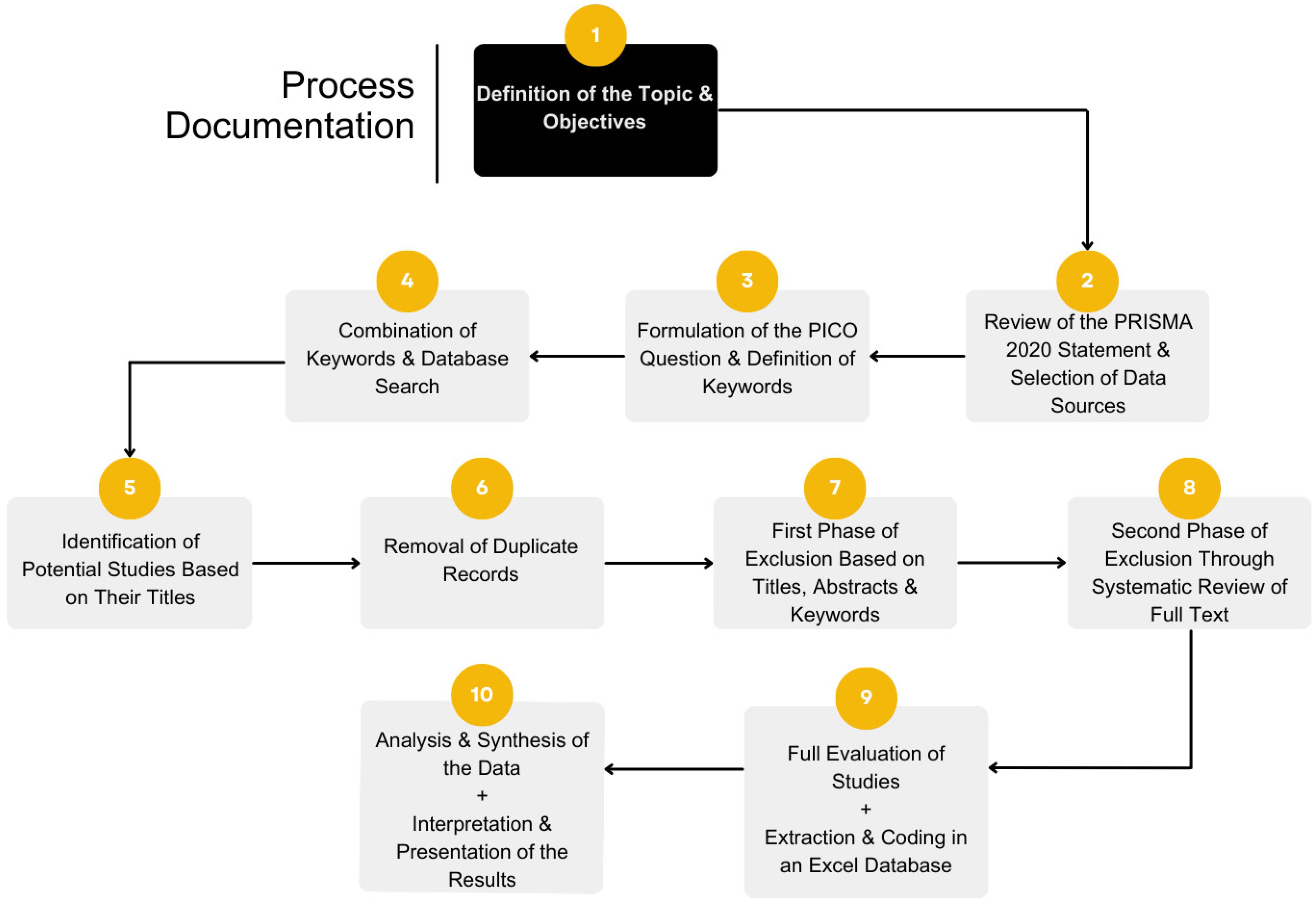
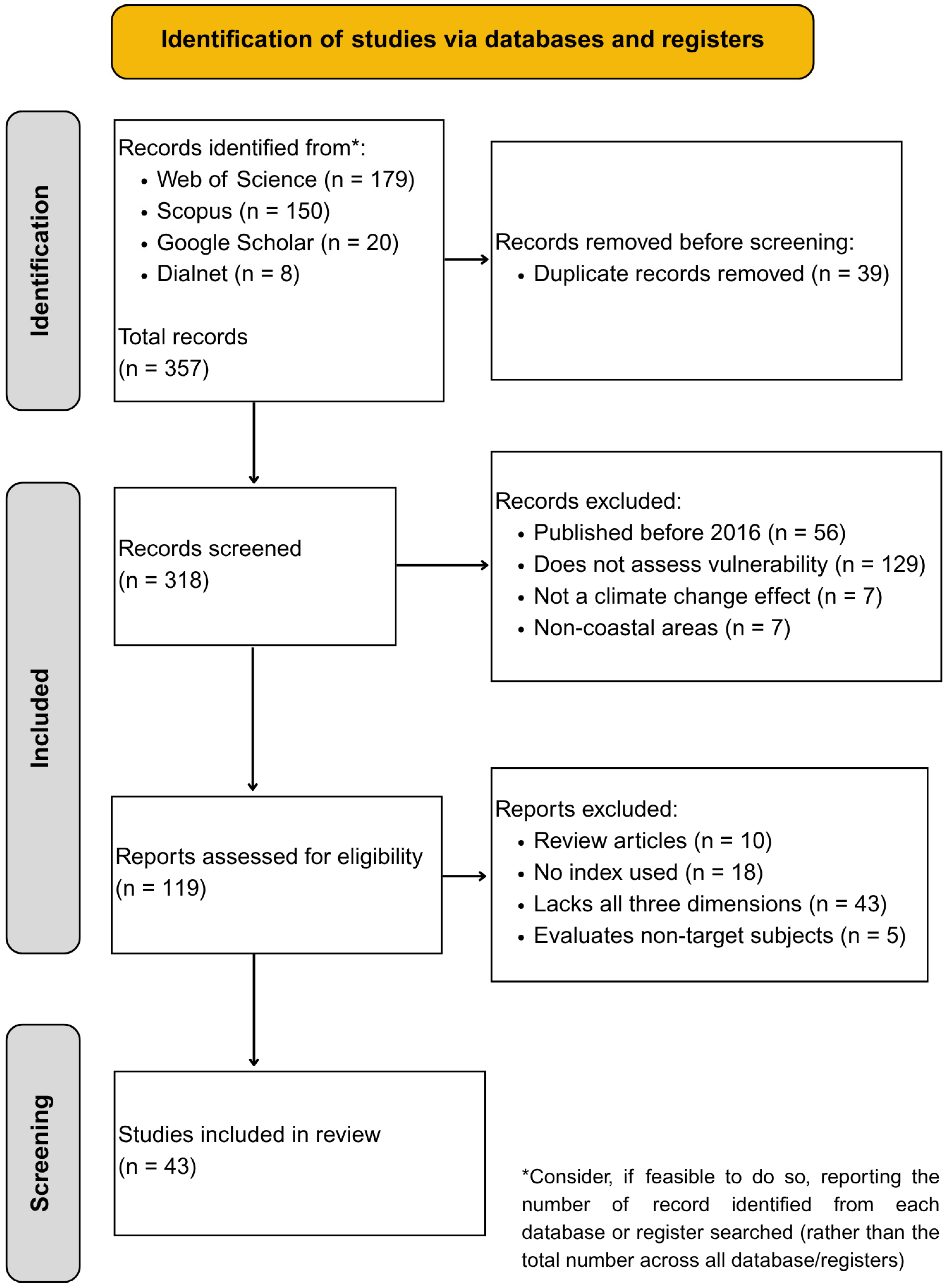
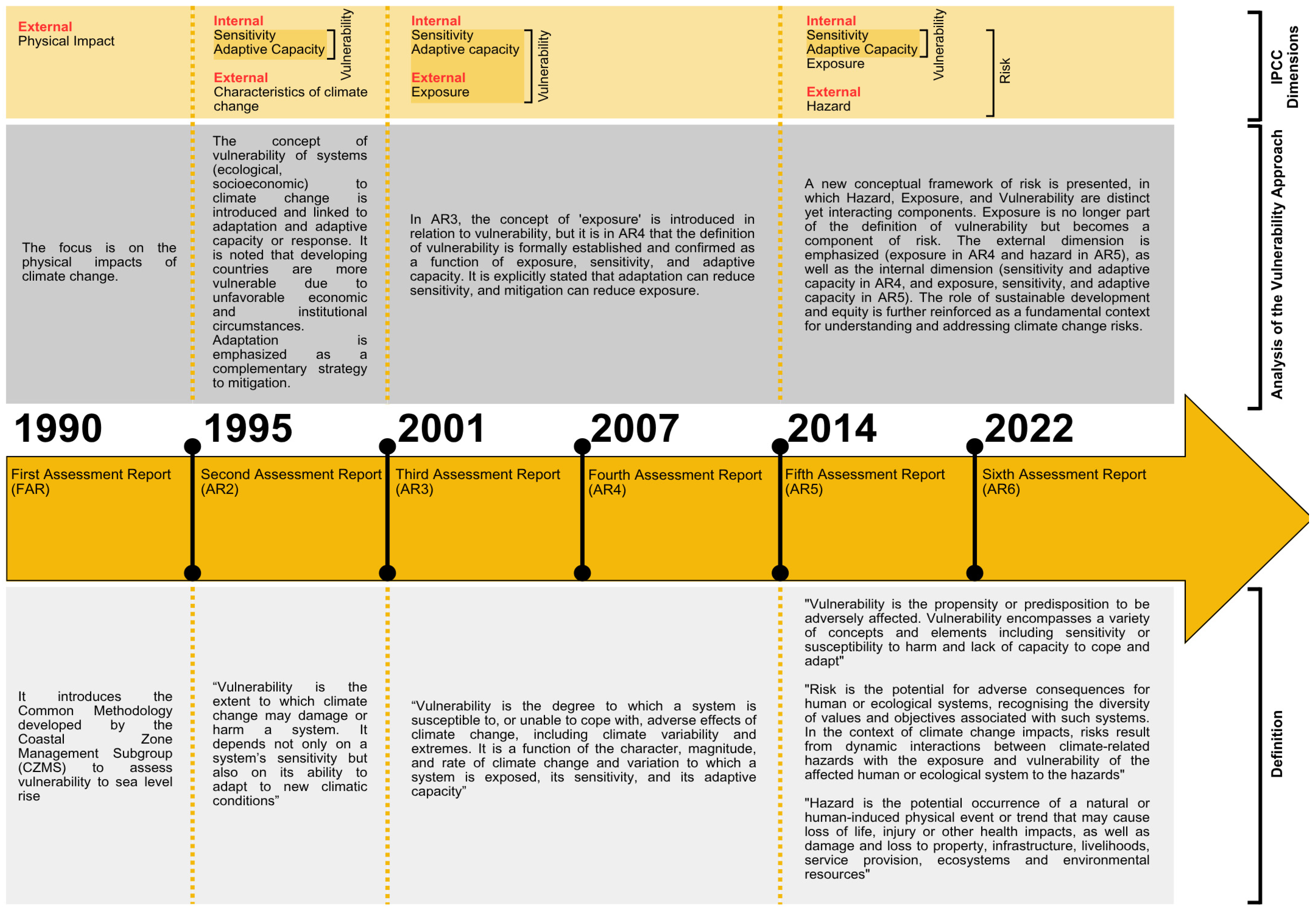
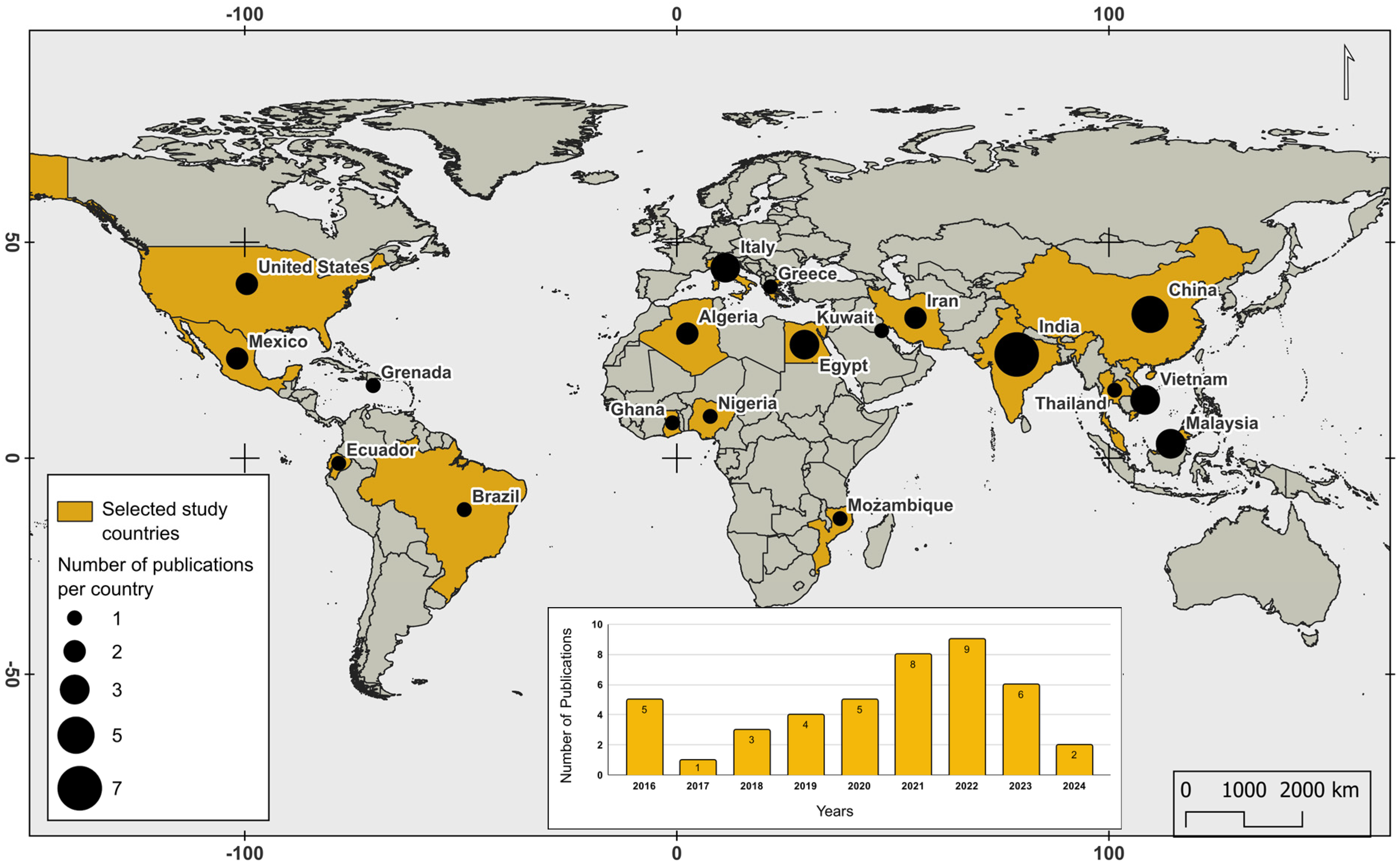
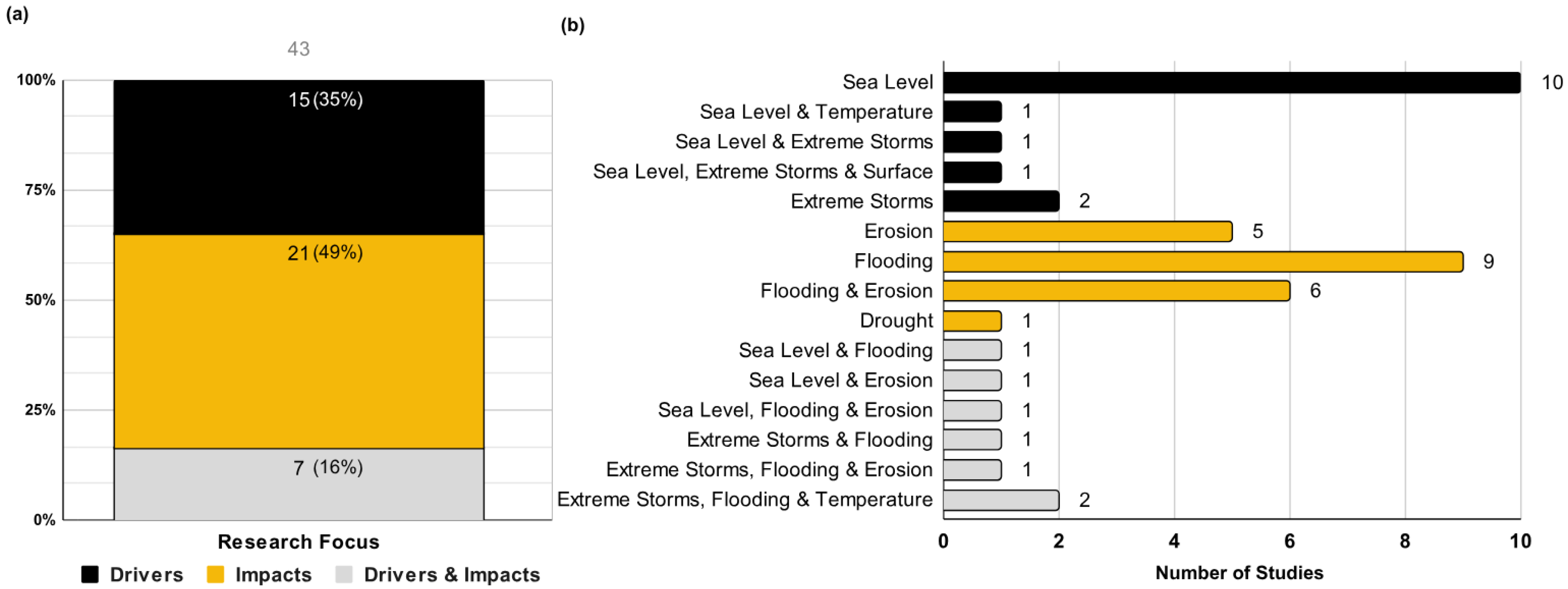
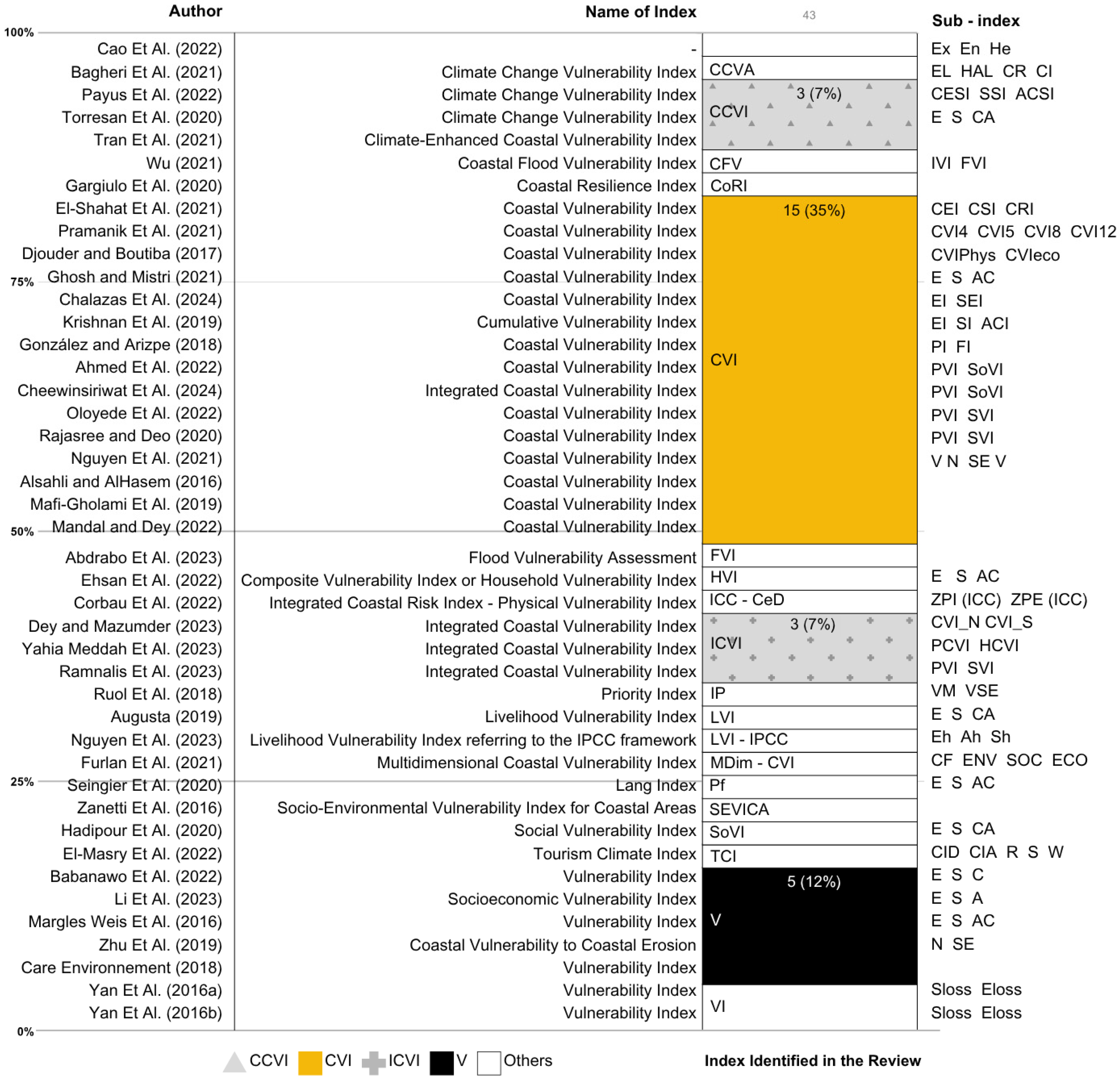
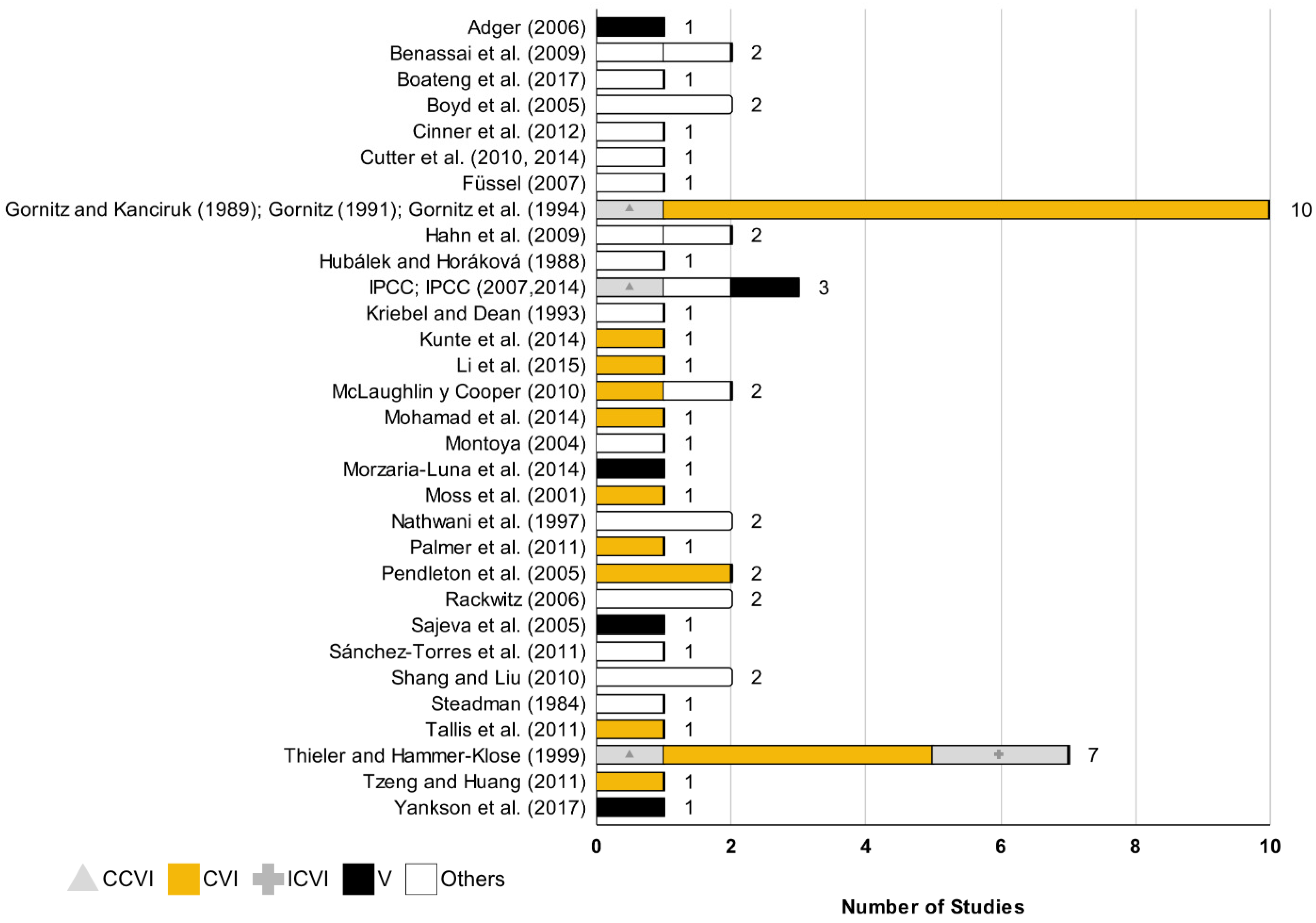
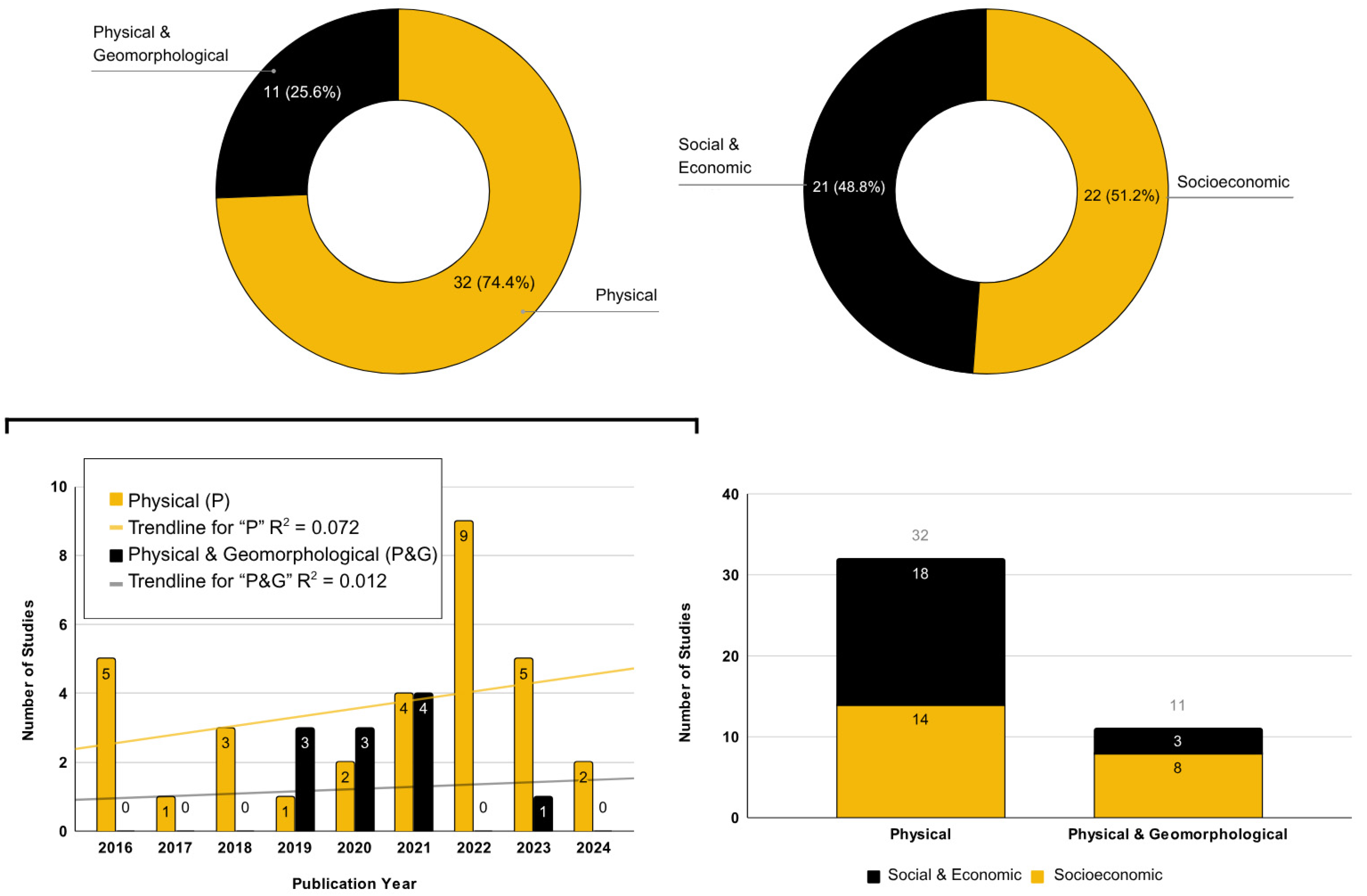
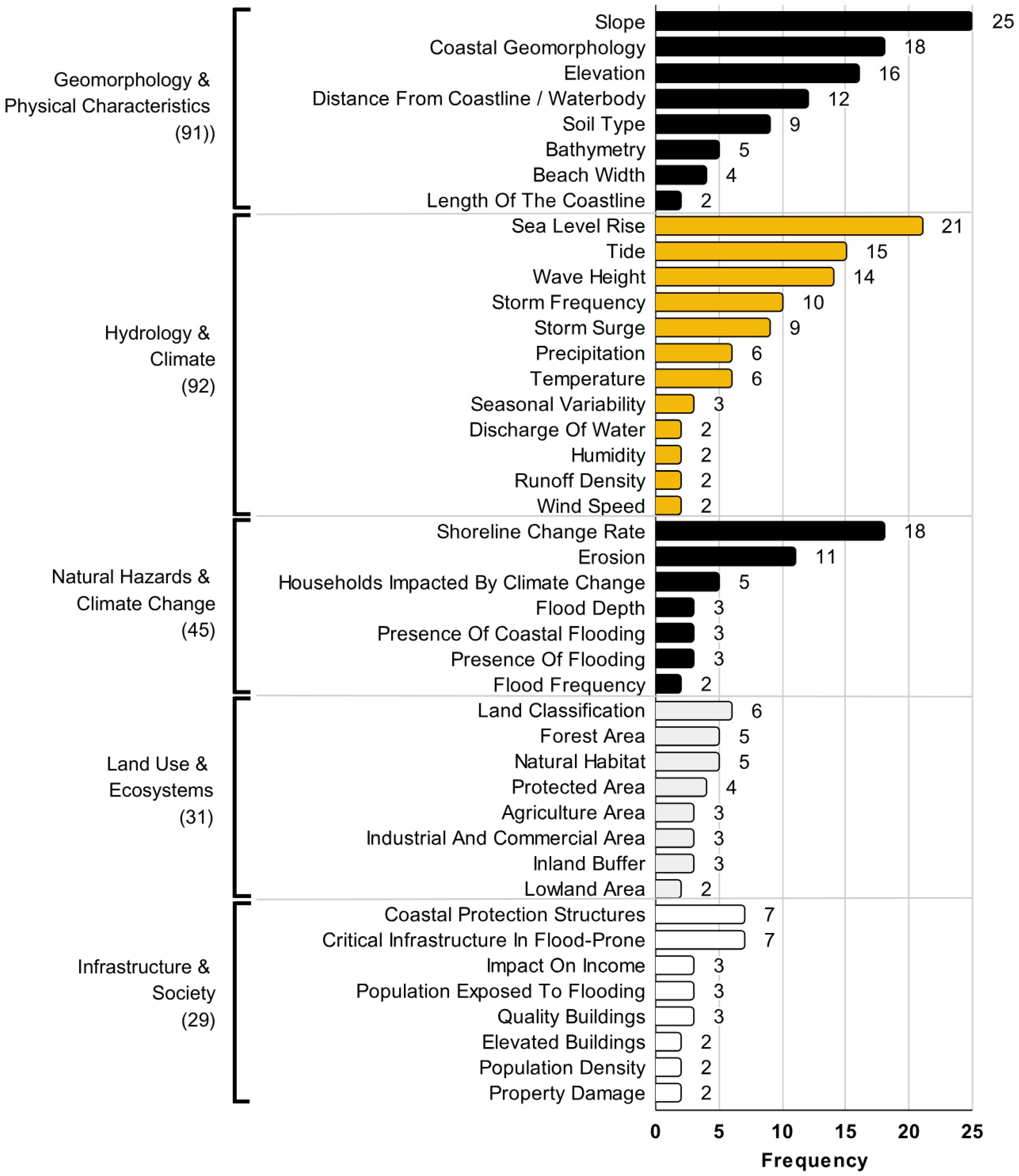
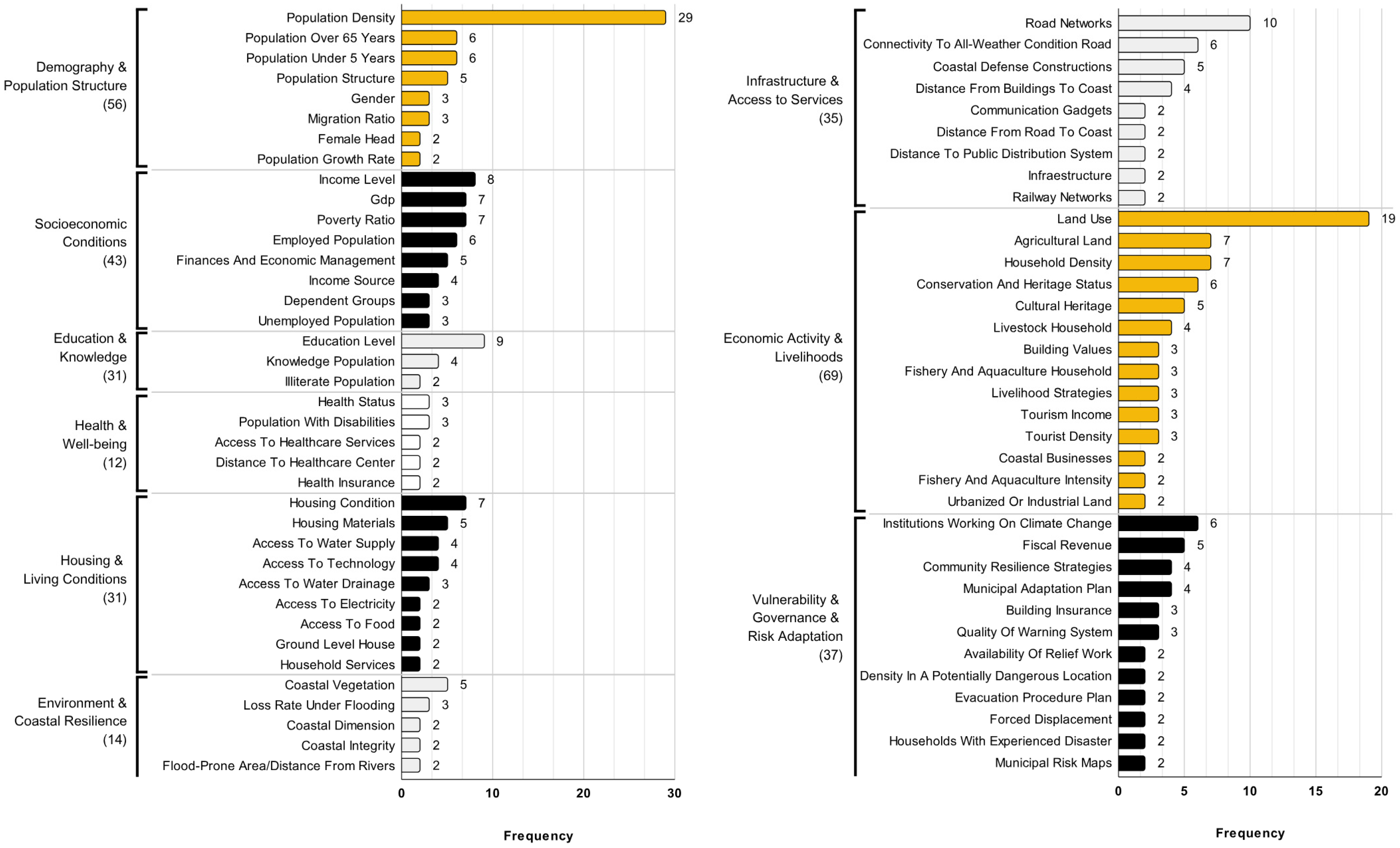
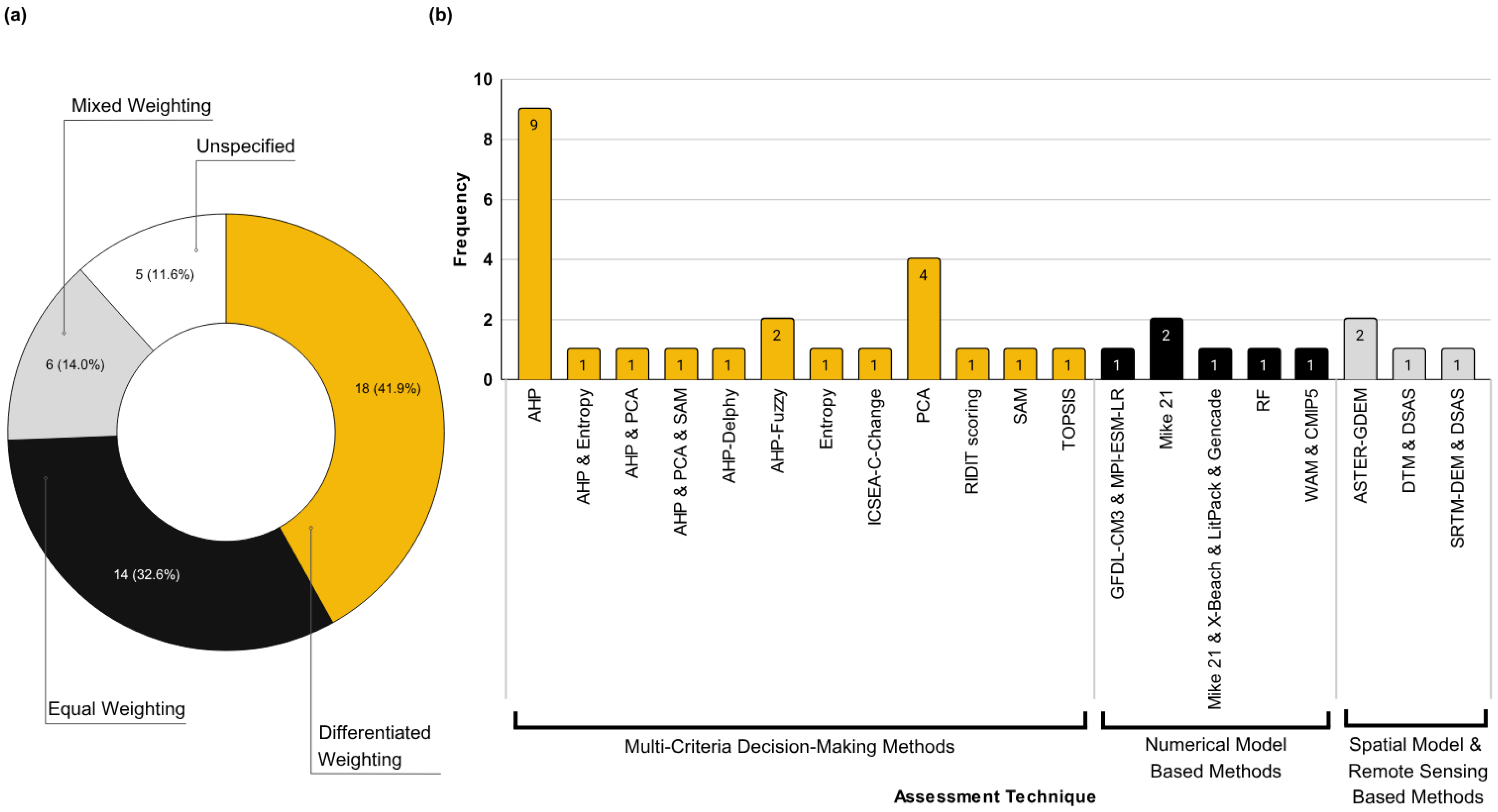
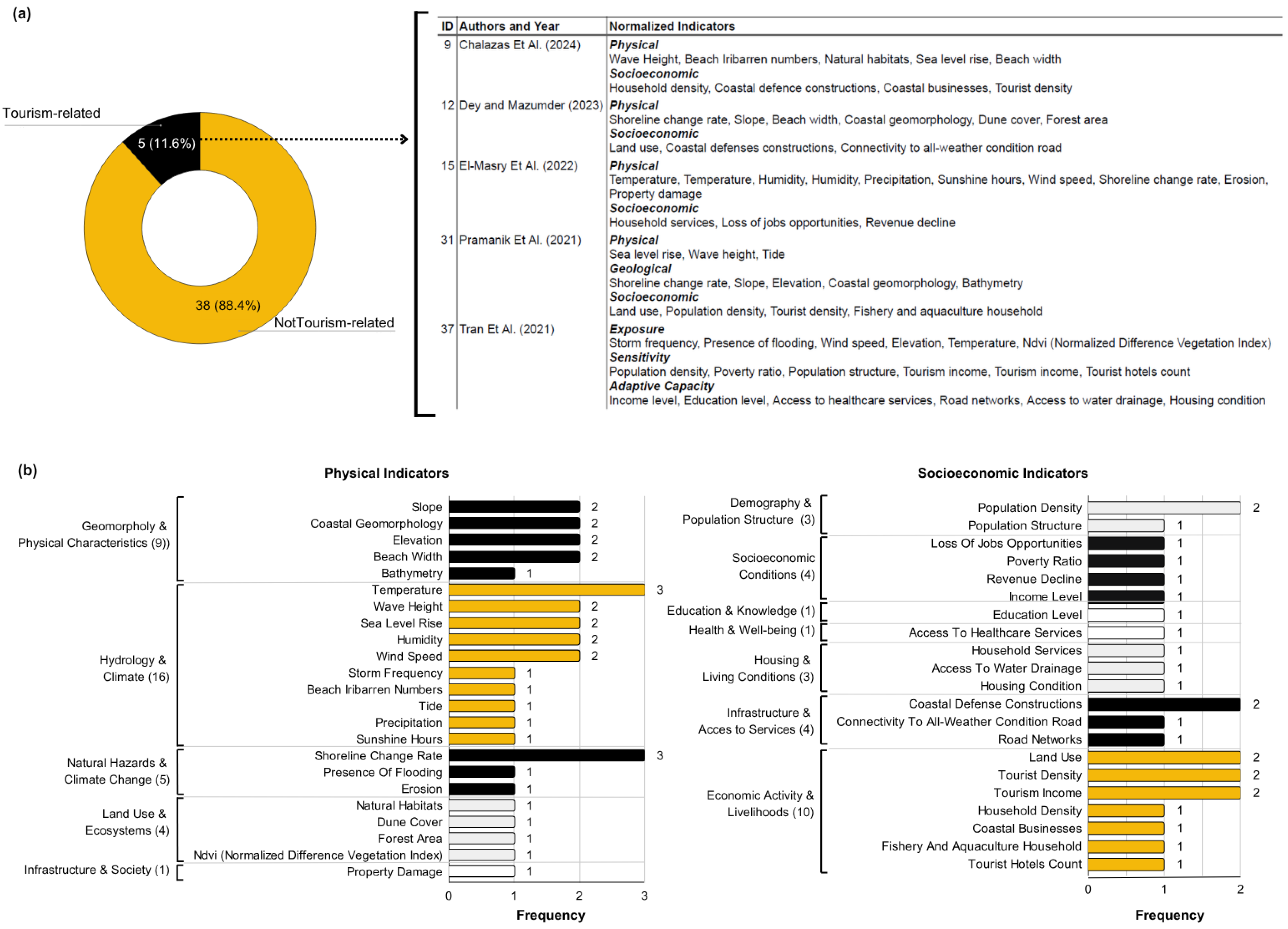
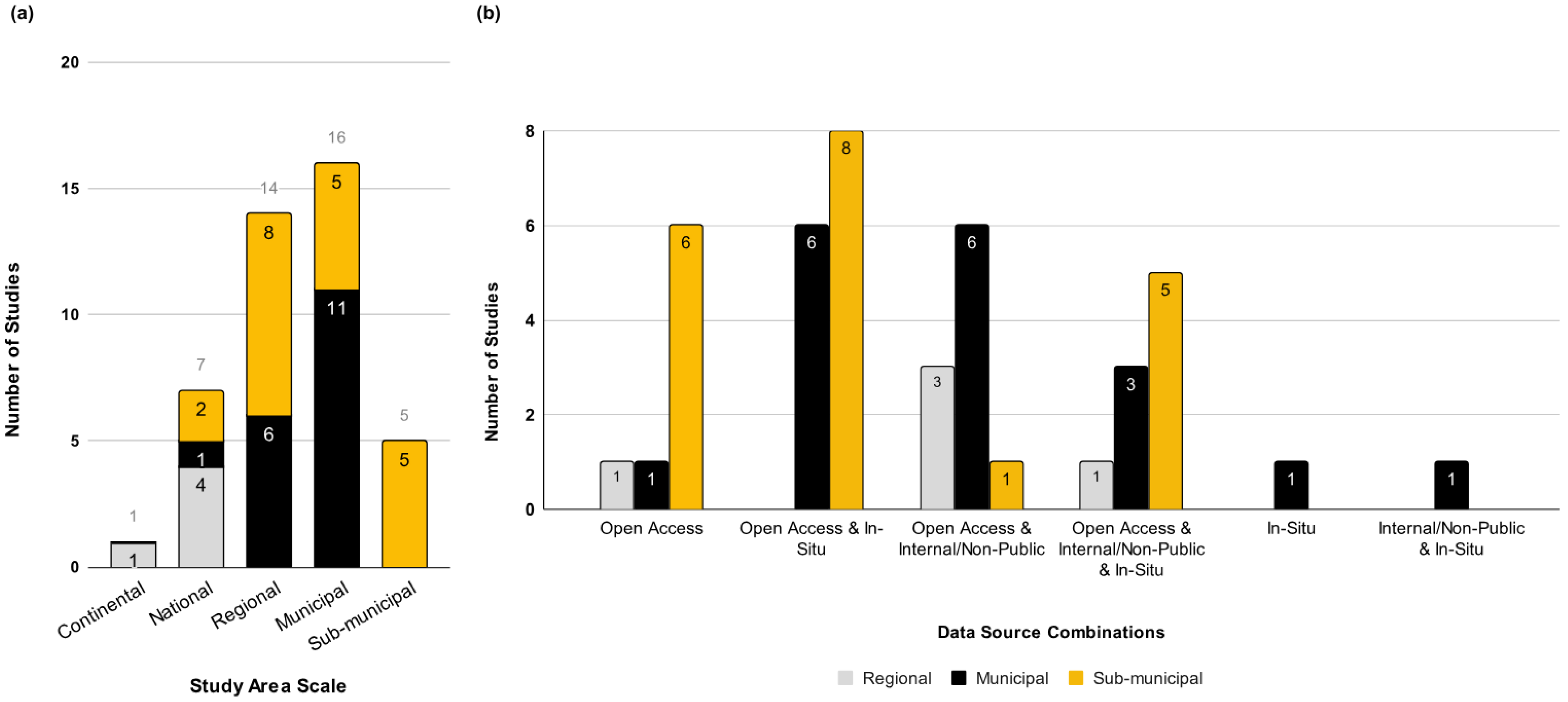
Disclaimer/Publisher’s Note: The statements, opinions and data contained in all publications are solely those of the individual author(s) and contributor(s) and not of MDPI and/or the editor(s). MDPI and/or the editor(s) disclaim responsibility for any injury to people or property resulting from any ideas, methods, instructions or products referred to in the content. |
© 2025 by the authors. Licensee MDPI, Basel, Switzerland. This article is an open access article distributed under the terms and conditions of the Creative Commons Attribution (CC BY) license (https://creativecommons.org/licenses/by/4.0/).
Share and Cite
Gasalla-López, B.; Arcila-Garrido, M.; Chica-Ruiz, J.A. Assessment of Climate Vulnerability Indices for Coastal Tourism Destinations. Atmosphere 2025, 16, 1171. https://doi.org/10.3390/atmos16101171
Gasalla-López B, Arcila-Garrido M, Chica-Ruiz JA. Assessment of Climate Vulnerability Indices for Coastal Tourism Destinations. Atmosphere. 2025; 16(10):1171. https://doi.org/10.3390/atmos16101171
Chicago/Turabian StyleGasalla-López, Beatriz, Manuel Arcila-Garrido, and Juan Adolfo Chica-Ruiz. 2025. "Assessment of Climate Vulnerability Indices for Coastal Tourism Destinations" Atmosphere 16, no. 10: 1171. https://doi.org/10.3390/atmos16101171
APA StyleGasalla-López, B., Arcila-Garrido, M., & Chica-Ruiz, J. A. (2025). Assessment of Climate Vulnerability Indices for Coastal Tourism Destinations. Atmosphere, 16(10), 1171. https://doi.org/10.3390/atmos16101171





